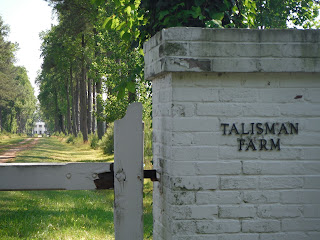
Hello again! Today we were fortunate enough to wake up dry thanks to the graciousness of CBF who let us come inside out of the rain last night to sleep. We headed to the eastern shore of Maryland around the Grasonville area to meet up with Ned Gerber of the non-profit Chesapeake Wildlife Heritage. We were in awe as we entered an absentee estate. The tall planted pines along the driveway led us up to a mansion from the 1930's. Our mouths literally dropped to learn about the history of the site and the nature of the property. The original owner avoided some taxes by living in Maryland and FLYING to work everyday in New York. Ned has been working with the current owner to increase the amount of wetlands and buffer strips around the farmed property. Corn and soybeans are grown by the farmers who rent some of the land for around $80-100 an acre. Through the Farm Bill the land owner can receive more than double that rental cost for acres that are set aside as buffers and wetlands. This is a great incentive to continue farming but incorporate practices that help to contain nutrients and soil.
 |
Walking through no-till corn fields, a production method
that is less destructive and helps to keep nitrogen,
phosphorus, and sediment out of the bay. |
The wetlands are created by first checking soil maps and topographical gradients to see where a wetland would potentially have been in the past or where it would do the best now. Then the soil is probed to check the data and a mapped plan is set in motion. The average amount of drainage into these wetlands varies from only a few acres up to a hundred which determines the size and number of emergency spillways that need to be created. The average depth for these wetlands is very shallow, rarely above two or three feet because many wetland plant species require oxygen for germination and therefore will need to dry out during some part of the year. Weirs and drain pipes are also installed to keep the water level in check. The landowner can see monetary value in creating these buffers and wetlands but the farmers can also be benefited because wetlands help hold in water which keeps the water table closer to the surface helping crops, especially when threats of drought and severe weather become more apparent.
 |
Julius Neill creates wildlife
habitat with logs in wetlands. |
 |
A weir blocks the drainage
pipe of a wetland to control
water level. |
Although money is a great incentive for people to move their land into natural systems there are other values too. One way that a lot people are "hooked" to create wetlands is wildlife like waterfowl and fish. I can really relate to this because my experiences of fishing and outdoor adventure as a young adult really helped sparked my admiration and desire to retain and restore the natural world and its' bounty. I can also think back to how natural systems can be more profitable than man made created systems. For instance, rain forests can provide an abundance of fruit which will forever provide sustenance and cash but the timber value will take decades to regenerate if cut. Additionally it can be so easy to work with nature rather than against it. It seems insane to me that we try so hard to irrigate places like the southwest desert for fruit and nut trees. I am also reminded that resources are there if you look in the right place. There is so much stuff in the world from man made objects like cars and pre-cut boards to natural things like fish and berries. If we look in the right place and put in a little bit of work we can get these things for next to nothing. I love making something out of nothing. It is a great feeling to know you can rely on your smarts and craftiness instead of buying your way out.
We were so lucky to have had the opportunity to visit the Chesapeake Bay and the surrounding area. I have learned more than I can write on this blog without drowning our page with information but I hope these bits and thoughts are spurring and enjoyable. We concluded today's efforts with a walk along the beach, great conversation, and also saved some Horseshoe Crabs. It will be a memorable day and trip for sure and I would be lying if I said that a part of me does not want to remain a part of the Chesapeake Bay.
 |
Horseshoe crabs are living fossils, but when they wash up
on shore, they often flip and can't right themselves.
How have they survived for millions of years? |






No comments:
Post a Comment